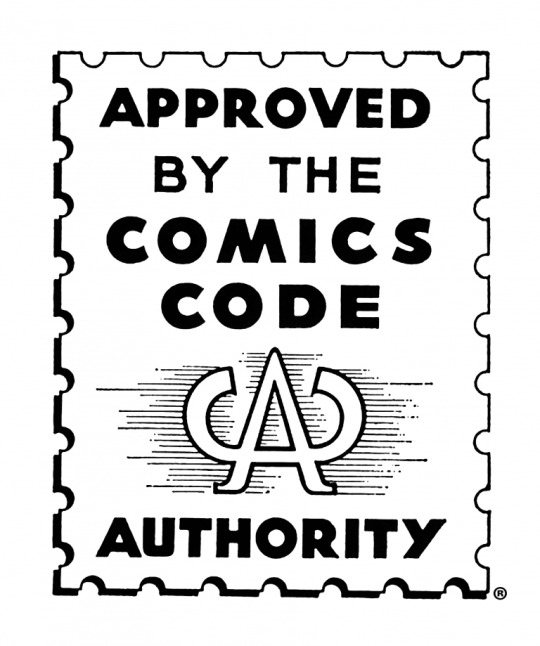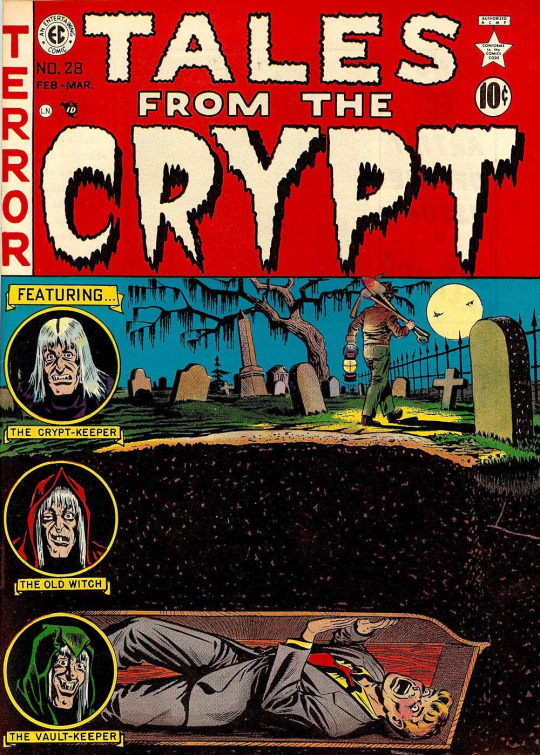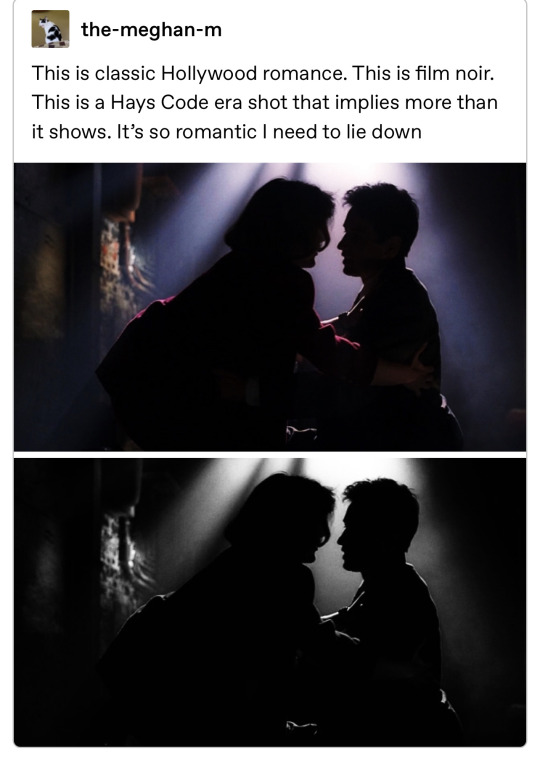#hays code
Text
Fondly remembering that time in the early 2000s when my mother and I stumbled on a (illegal) Christian Movie website that edited out anything ‘not Christian’ out of all your faves by cutting out entire scenes and bleeping curse words, and that special moment when we saw ‘H*llboy’s’ runtime being under 20 minutes and absolutely lost it.
1K notes
·
View notes
Text
T shirt that says I VIOLATE THE HAYS CODE
5K notes
·
View notes
Text
Instead of saying "I want to kill myself" I now say "I'm going to violate the Hays Code." "I'm going to violate YouTube terms of service." Or "I'm going to violate the comics code." And I hate realizing all three of those mean the same thing. Progress is moving backwards in this society.
#anti censorship#anti capitalist#anti capitalism#196#my thougts#free speech#leftist#left#leftism#youtube#hays code#comics code authority
170 notes
·
View notes
Note
Was the Comics Code as bad as the Hays Code?

That's a really good question!
I suppose it depends on what you mean by "as bad" - are we talking about the overall impact of the Code on American pop culture or are we talking about the actual content of the Code and what it banned and/or mandated in terms of artistic expression?
I've written a little bit about the Hays Code here, but my main focus was on subtextual judaism in Hollywood generally rather than what the Code was and what its impact on American cinema was.

So what did the Hays Code actually include?
One of the few positive things you can say about it is that the men who devised it were quite clear and forthright about what would and wouldn't be allowed, in comparison to the vagueness and inconsistency of the modern MPAA. So here's the list of what couldn't be shown:
Pointed profanity—by either title or lip—this includes the words God, Lord, Jesus, Christ (unless they be used reverently in connection with proper religious ceremonies), Hell, S.O.B., damn, Gawd, and every other profane and vulgar expression however it may be spelled; (You'll notice that the Code is very much a snapshot of the transition from silent movies to "talkies," with the discussion of how profanity is spelled as well as produced via "lip.")
Any licentious or suggestive nudity—in fact or in silhouette; and any lecherous or licentious notice thereof by other characters in the picture;
The illegal traffic in drugs;
Any inference of sex perversion; (i.e anything having to do with LGBT+ people and culture. For more on the impact of the Hays Code on the LGBT+ community, see the excellent documentary the Celluloid Closet.)
White slavery; (the 1920s version of sex trafficking, but with added racism!)
Miscegenation;
Sex hygiene and venereal diseases;
Scenes of actual childbirth—in fact or in silhouette;
Children's sex organs;
Ridicule of the clergy;
Willful offense to any nation, race or creed; and (this one was really honored in the breach more than the observance when it came to nations, races, and creeds of non-dominant groups in society.)
The following things could be shown, but "special care be exercised in the manner in which the following subjects are treated, to the end that vulgarity and suggestiveness may be eliminated and that good taste may be emphasized:"
The use of the Flag;
International Relations (avoid picturizing in an unfavorable light another country's religion, history, institutions, prominent people and citizenry); (again, depended a lot on what country you're talking about.)
Arson;
The use of firearms;
Theft, robbery, safe-cracking, and dynamiting of trains, mines, buildings, et cetera (having in mind the effect which a too-detailed description of these may have upon the moron); (I guess the idea was that the MPPDA believed very strongly in the idea that media could affect people's behavior through imitation, but the use of the word "moron" gives me eugenics vibes.)
Brutality and possible gruesomeness;
Technique of committing murder by whatever method;
Methods of smuggling;
Third-Degree methods; (i.e, torture)
Actual hangings or electrocutions as legal punishment for crime;
Sympathy for criminals; (this was a big one; Hollywood had done very well from gangster films, so a lot of creators had to do some careful threading of the needle to keep the genre alive. One dodge that they came up with was that they would have a duplicate "final reel" in which the gangster would have their inevitable comeuppance, and then remove the final reel when the censors had left the theater. Very popular with white rural teens.)
Attitude toward public characters and institutions; (again, Hollywood shifting from being anti- to pro-establishment.)
Sedition;
Apparent cruelty to children and animals;
Branding of people or animals;
The sale of women, or of a woman selling her virtue;
Rape or attempted rape;
First-night scenes; (i.e, wedding nights)
Man and woman in bed together; (hence the eventual TV practice of showing married couples in separate beds in the 50s)
Deliberate seduction of girls;
The institution of marriage;
Surgical operations;
The use of drugs;
Titles or scenes having to do with law enforcement or law-enforcing officers;
Excessive or lustful kissing, particularly when one character or the other is a "heavy".
So in general, we can say that the Hays Code was extremely sex-negative, very concerned about crime and anti-establishment thinking, sexist, racist, and homophobic, and in general afraid of offending anybody.
So what about the Comics Code Authority?
So this is what the Comics Code looked like in 1954:
Crimes shall never be presented in such a way as to create sympathy for the criminal, to promote distrust of the forces of law and justice, or to inspire others with a desire to imitate criminals.
If crime is depicted it shall be as a sordid and unpleasant activity.
Policemen, judges, government officials, and respected institutions shall never be presented in such a way as to create disrespect for established authority.
Criminals shall not be presented so as to be rendered glamorous or to occupy a position which creates a desire for emulation.
In every instance good shall triumph over evil and the criminal punished for his misdeeds.
Scenes of excessive violence shall be prohibited. Scenes of brutal torture, excessive and unnecessary knife and gunplay, physical agony, the gory and gruesome crime shall be eliminated.
No comic magazine shall use the words "horror" or "terror" in its title.
All scenes of horror, excessive bloodshed, gory or gruesome crimes, depravity, lust, sadism, masochism shall not be permitted.
All lurid, unsavory, gruesome illustrations shall be eliminated.
Inclusion of stories dealing with evil shall be used or shall be published only where the intent is to illustrate a moral issue and in no case shall evil be presented alluringly, nor so as to injure the sensibilities of the reader.
Scenes dealing with, or instruments associated with walking dead, torture, vampires and vampirism, ghouls, cannibalism, and werewolfism are prohibited.
Profanity, obscenity, smut, vulgarity, or words or symbols which have acquired undesirable meanings are forbidden.
Nudity in any form is prohibited, as is indecent or undue exposure.
Suggestive and salacious illustration or suggestive posture is unacceptable.
Females shall be drawn realistically without exaggeration of any physical qualities.
Illicit sex relations are neither to be hinted at nor portrayed. Rape scenes, as well as sexual abnormalities, are unacceptable.
Seduction and rape shall never be shown or suggested.
Sex perversion or any inference to same is strictly forbidden.
Nudity with meretricious purpose and salacious postures shall not be permitted in the advertising of any product; clothed figures shall never be presented in such a way as to be offensive or contrary to good taste or morals.[16]
You'll notice the similarities when it comes to the Codes' attitude to sex, sexuality, crime, and symbols of authority - so to answer the first part of your question, I would say the CCA was pretty similar to the Hays Code (in part because Charles F. Murphy, who drew it up, was deeply unoriginal and basically cribbed off the Hays Code throughout).
However, there are also some significant areas of difference that have a lot to do with the unique circumstances of the 1950s moral panic over comics. See, in the 1950s, superhero comics were considered deeply uncool and old hat - they had been huge in the 40s during the war, but by the 50s the biggest genre in comics were horror, crime, and romance comics (with cowboy comics bringing up the rear). To quote myself from another post:
"This gave rise to a moral panic in the 1950s, although more accurately it was part of the larger moral panic over juvenile delinquency. The U.S Senate established a Juvenile Delinquency Subcommittee of the Judiciary Committee in 1953 to investigate the causes of juvenile delinquency and comics became a major target. While Wertham’s book is best known today for its assertions that Batman and Robin were teaching young boys to be gay and Wonder Woman was teaching young girls to be lesbians, the main focus of the Subcommittee [edit mine: and Wertham's academic work] was on horror and crime comics for their depiction of sex, violence, and “subversive” attitudes to law and order."

The CCA made it impossible to publish two of the most popular genres in the industry for a generation (the CCA relaxed its stance on horror stuff a bit in the 70s, which is why Marvel trend-chased werewolves and vampires the moment they could get away with it), which not only scrambled the medium (and potentially created space for the Silver Age of superhero comics to flourish) but drove the former titan EC Comics practically out of business. (Indeed, William Gaines of EC Comics believed that the CCA had been specifically worded to drive him out of business.)
So in some ways, the CCA was worse.
#subtexual judaism#cultural history#film history#hays code#comics#comics meta#comics code authority#cinema
190 notes
·
View notes
Text
I’d like to strap down all these young queer folks who want to bring back the Hays Code and make them watch The Celluloid Closet. That documentary shook me so hard I was sobbing by the end. I was 22 when I first saw it; I’m 41 now. It still brings me to tears. I can’t begin to explain how important it is to know our history in media. In fact, it’s staggering how lasting the damage has been to all marginalized communities in cinema (POC, disabled people, and the list goes on). We cannot do this again. We cannot.
544 notes
·
View notes
Text
i'm not the first to point out that popular film criticism has resurrected hays code level objections to sexuality and morally dubious behaviour, but i think that what lies at the core of this is the idea that films are expected to instruct their viewers on proper behaviour. the viewer becomes an infantilized receiver of moral lessons, which must be taught in simple terms, lest their most unreasonable and twisted interpretations are spread by the masses.
i was incredibly disappointed by many reviews of the barbie movie and of poor things, which seemed unable to let go of their vision of what those films should have been, and how the - in this case feminist - message should have been transmitted, instead of engaging with them as they are.
that doesn't mean that we shouldn't criticise their shortcomings, but we can't project massive expectations onto every movie that comes out that could maybe possibly have some kind of progressive message and judge it by its correctness before we judge it by its value.
self-infantilization is not a good idea in the long run, and artists aren't mother goose.
91 notes
·
View notes
Text



The Motion Picture Production Code (colloquially known as the Hays Code) circa 1956 vs Tumblr Fandom Police circa 2023
Spot the difference!
#proship#anti censorship#hays code#i wanted to add more examples of antis basically saying thought crimes are real#but tbh my folder of screenshots is soooo looonnggg and i have better things to do#feel free to add more examples in the reblogs tho :)#history is a straight line etc etc#also i know the hays code is from the 30s but this specific screenshot is of a printed copy of it from 1956
59 notes
·
View notes
Text
52 notes
·
View notes
Text

Laura (1944) directed by Otto Preminger. Above NYC police detective Mark McPherson (Dana Andrews) questions newspaper columnist Waldo Lydecker (Clifton Webb) about the murder of advertising executive Laura Hunt.
The character of Waldo Lydecker was originally written as being homosexual but due to the Hays Code all references to sexuality were removed. Preminger hired actor Clifton Webb to play the part. Webb had not been in a movie since 1930, but was well known on Broadway and in NYC. He was also Gay and while all written references to the characters sexuality were removed, countless articles have been written on the characters ambiguous sexuality.
52 notes
·
View notes
Text



The Hays Code is a great canvas for blackout poetry
286 notes
·
View notes
Text
I’ve seen people criticize Asteroid City for obfuscating the story unnecessarily, and I have to say that if you’ve read The Celluloid Closet or seen the documentary, you’d know the layers of meaning imbued in Hays Code films that couldn’t be expressed explicitly. The love story between Jones and Conrad frames the play and the themes of isolation and alienation queer people felt in the 1950s are written in the play. The movie is about subtext made textual through telling the lives of the queer people who made the play a reality.
#asteroid city#Wes Anderson#jones hall#Conrad Earp#films#asteroid city 2023#jason schwartzman#augie steenbeck#midge Campbell#the celluloid closet#celluloid closet#hays code
57 notes
·
View notes
Text
There are so many moments in Rope (1948) where Phillip is leaning against Brandon or closer to Brandon or into Brandon and it’s like damn dude we know you want your boyfriend to hold you so bad but the Hays code said he can’t
48 notes
·
View notes
Text
Tim Minear, I got a fucking bone to pick with you.
How the fuck did Nick and Nora, made during the infamous Hays Code era by the way, make out more times than Bobby and Athena? Like I’m not counting (I am and it is zero) but how is that exactly possible?
The film’s characters, supposedly married, weren’t even allowed for sleep in one bed because of those ridiculous rules and yet they seemed to convey more affection and sexual tension.

Meanwhile, you have no such restrictions with these actors today. We’re not even asking them to have movie magic sex, sir. We were just hoping for some actual fun sleuthing adventures with our favorite chaotic couple.

—because that was the expectation you set when you said they were going to be like The Thin Man.
(This should have been a red flag honestly because—in my opinion—apart from “The Thrilling Adventure Hour’s Beyond Belief” with Frank and Sadie Doyle, there has never been a truly good adaptation or inspired piece of The Thin Man which actually has led me to think it’s some kind of curse on its own, like a mini-Macbeth)
How do you reference The Thin Man regarding the episode you wrote? Like sir, Nick and Nora were a rich, chaotic, drunk honeymooning, sleuthing couple with a funny little dog who just happened to solve crimes for funsies because the wise-cracking wife and her cute little nose would not let her husband stay out of trouble.
They made sleuthing look fun and marriage seem sexy which was already a revolutionary idea in the silver screens of the 1930s…like that is the complete opposite of what you wrote in “Abandon ‘Ships”, Mr. Minear. Did you even watch the movies or did someone just say, ‘hey, you know those black and white movies…?’
I don’t mind what you did in the episode. I mind that you uttered complete bullshit about it saying it’s like The Thin Man movies because, no, hell no. Not even close. I really don’t get how you pulled that comment from your ass, sir. Respectfully.
So did you lie or did you just choose to reference the film series because this is another jab at the Oscars? Because as it happens, they also presented the actress who played Nora, Myrna Loy (sidenote: everyone knew she should have won for the 1946 film “The Best Years of Our Lives”) an Honorary Oscar.
So what I’m actually saying is, you kinda suck for lying through your stupid teeth, Tim Minear. So like go kick rocks or something. And maybe don’t ever speak of The Thin Man again if you’re just gonna lie about it.
#angela bassett#athena grant#tv: 911#bathena#peter krause#bobby nash#bobby x athena#911 on abc#911#911 abc#the thin man#the thin man films#nick charles#nora charles#nick and nora#aster#hays code#tim minear#oscars#honorary oscar#thrilling adventure hour#beyond belief#frank doyle#sadie doyle
25 notes
·
View notes
Text

A whole 90 years later and antiships have the exact same principles.
#196#my thougts#leftist#leftism#proship#antiship#discourse#profic#pro ship#pro fiction#anti censorship#queer history#film history#hays code
132 notes
·
View notes
Text
inglorious basterds-like movie about a plot to kill hitler censored in the style of a tiktok
they have to “unalive” “Yahtzees” to get to “bad mustache man” but when they get to him they find he “kermitted sewerslide”
every time there’s a knife or gun on screen (every scene) text that says “⚠️ fake prop! ⚠️” appears next to the weapon
at a burlesque, “ADULT!” “⚠️ fake body! ⚠️” and “she’s wearing shorts!” pop up on screen with a translucent black box blocking any cleavage or skin above the knee
the characters are allowed to say slurs
#tiktok#unalive#yahtzees#bad mustache man#sewerslide#censorship#self censorship#hays code#inglorious basterds#cw nazi mention#cw hitler mention#cw suicide mention
23 notes
·
View notes
Text

So! Guess who was a complete imbecile and deleted their Tumblr by accident! 😭😭😭 gotta start over I guess.
#the x files#x files#txf#mulder and scully#mulder#scully#msr#fox mulder#dana scully#film noir#hays code#old hollywood#the jersey devil#jersey devil
129 notes
·
View notes